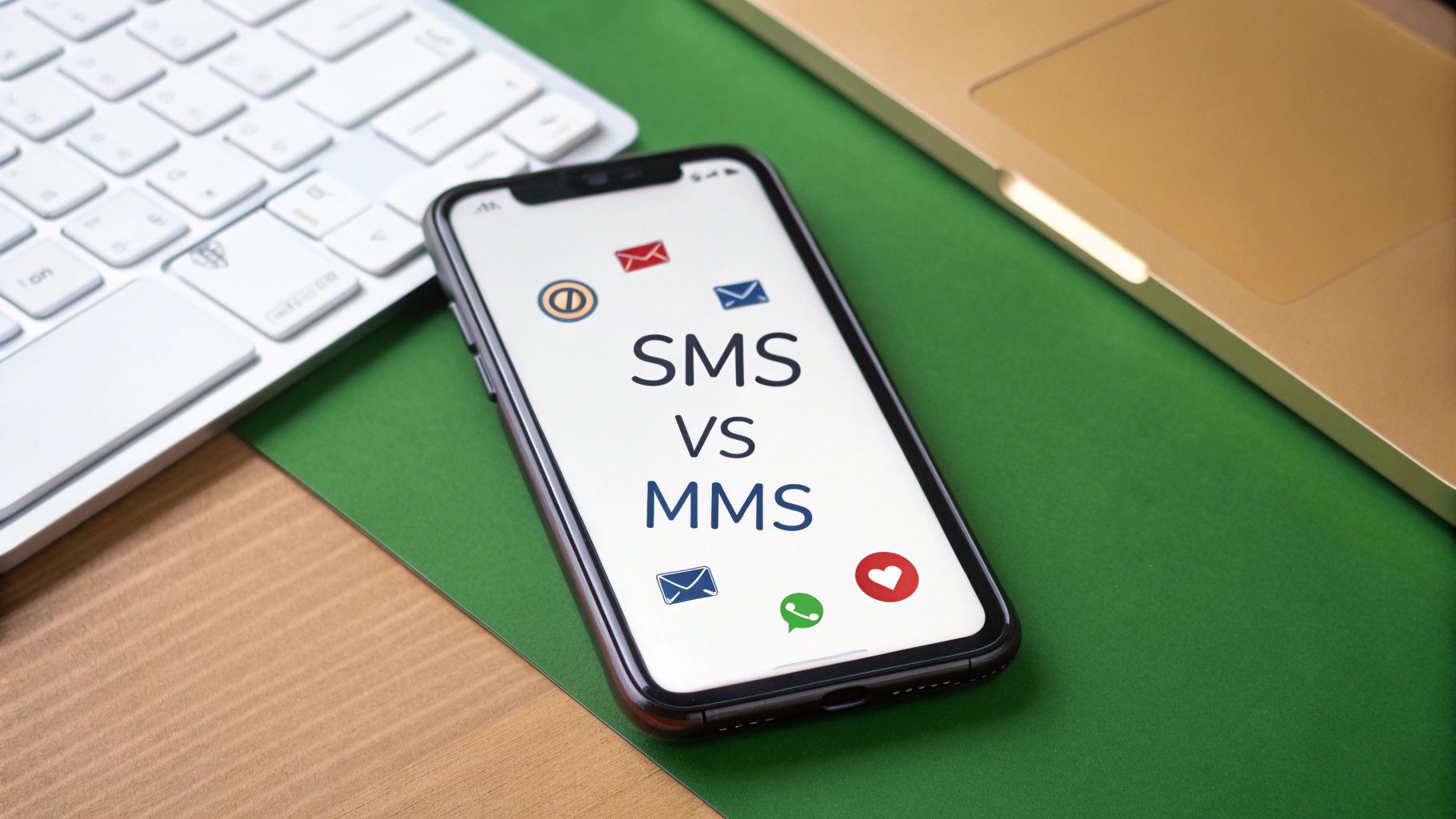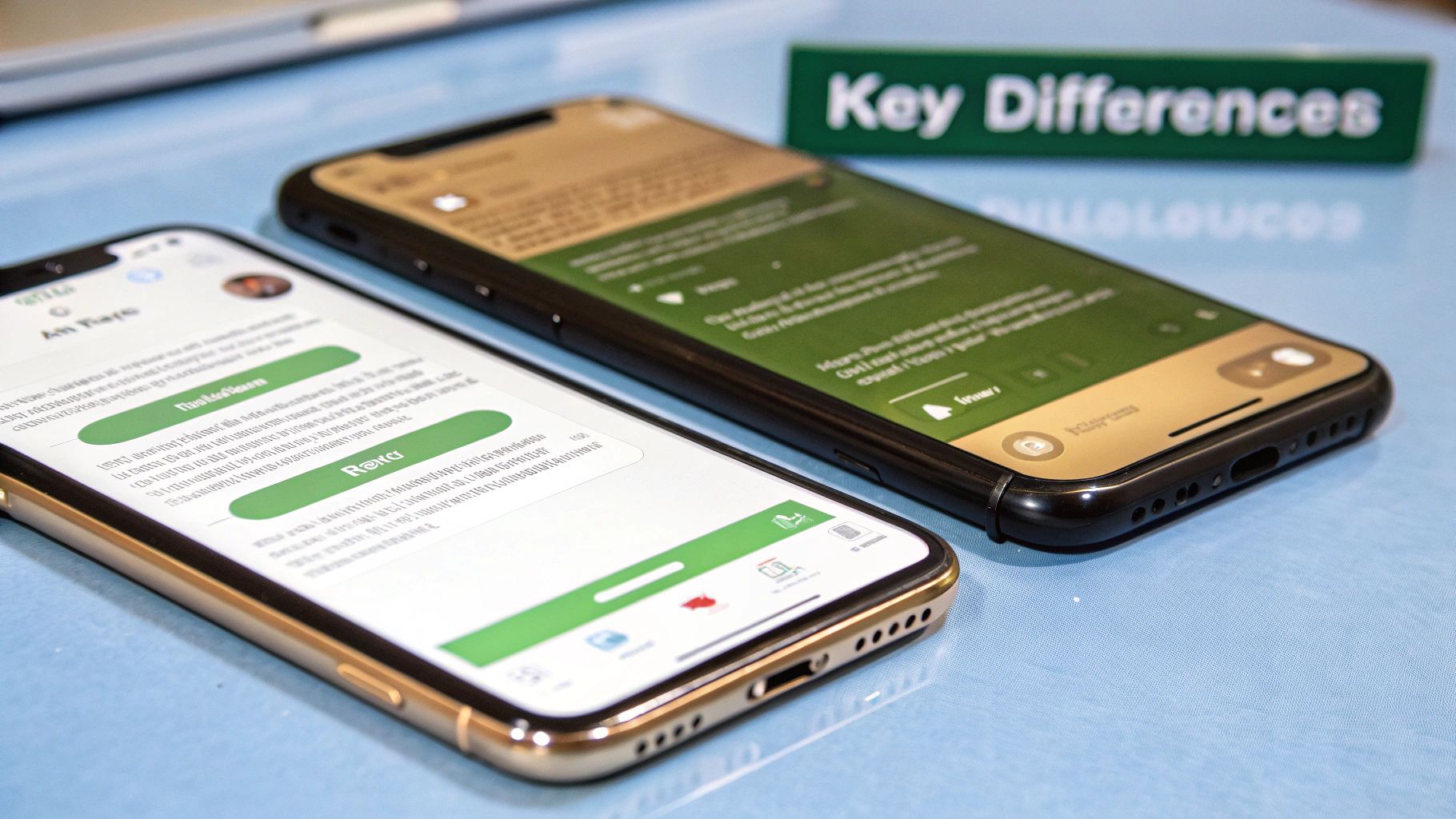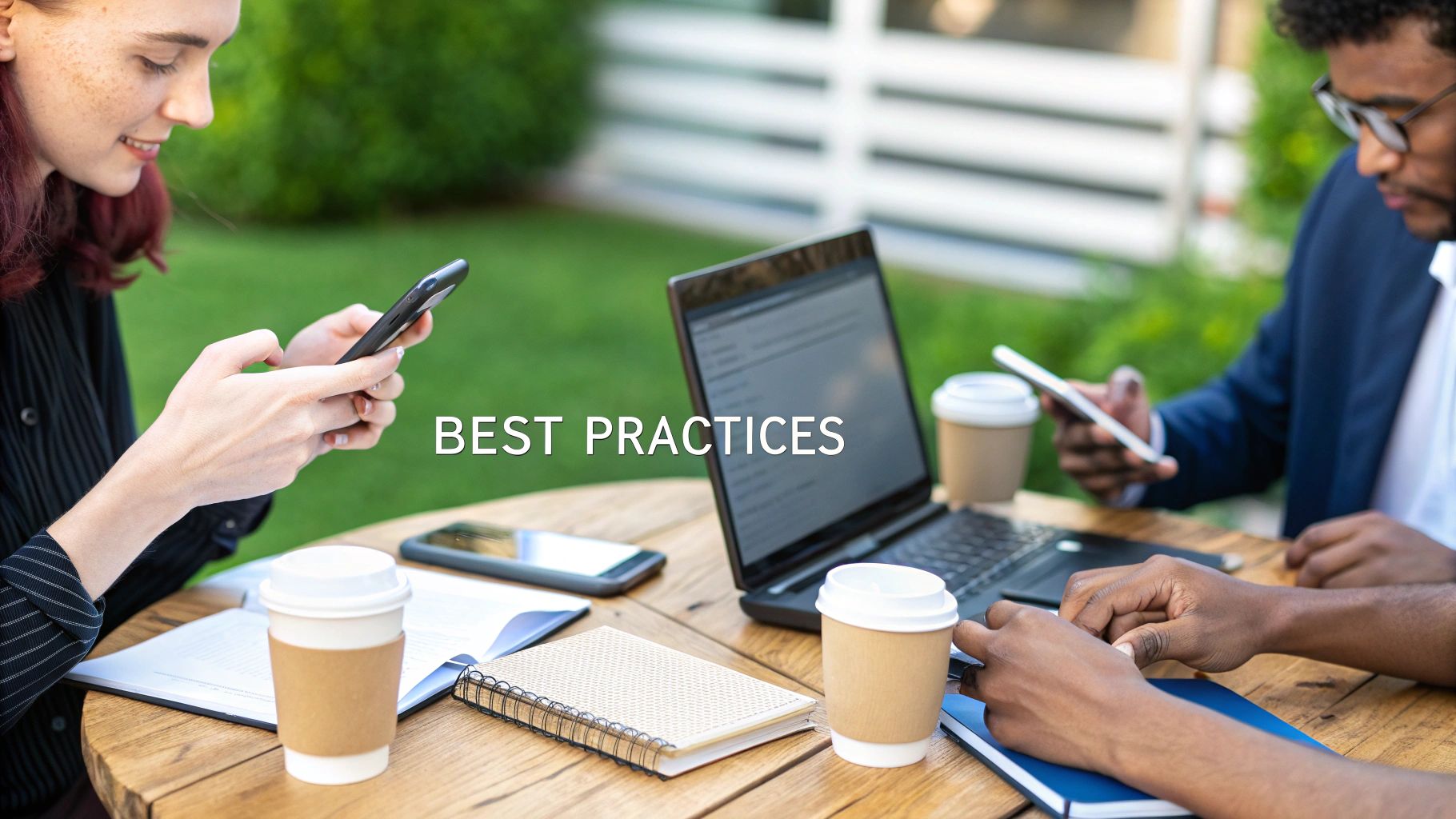At its core, the difference between MMS and SMS messaging is pretty straightforward: SMS (Short Message Service) is strictly for plain text, while MMS (Multimedia Messaging Service) handles rich media like images, videos, and audio. This single distinction shapes everything, from character limits and cost to how well you can actually connect with your audience.

MMS Vs SMS: A Quick Comparison For Businesses
Getting a handle on this difference is the first step toward building a mobile marketing strategy that actually works. Though they're both types of text messaging, their capabilities and ideal use cases are worlds apart. SMS is the original, no-frills format, valued for its incredible reliability and universal reach.
MMS came along later, building on what SMS started by allowing businesses to send a much more vibrant, visual story straight to a customer's inbox.
Key Differences at a Glance MMS vs SMS
To really see how MMS and SMS stack up, a direct comparison is the best way to go. Each format comes with its own set of rules and strengths, making it a better fit for certain business goals. This table breaks down the essentials.
As you can see, the formats are designed for very different jobs. While MMS lets you create a more dynamic and branded experience, SMS is the king of speed and attention.
In fact, SMS messages have an almost unbelievable open rate of nearly 98%, and most are read within just three minutes. This immediate impact is why SMS still dominates the market, making up 64.31% of all messaging value. MMS may have a smaller slice of the pie, but its ability to deliver rich, engaging content can give your campaigns a serious performance boost. For more deep-dive numbers, you can find great insights on text marketing statistics from TxtCart.
Ultimately, this isn't about which one is "better." It's about choosing the right tool for your message, your audience, and your budget.
How the Underlying Technology Affects Delivery
The real difference between SMS and MMS goes way beyond just text versus images. It gets down to the core technology that zaps these messages to your customer's phone, and knowing the "why" behind it is critical for any business. It explains why one message lands perfectly while another fails, which directly impacts your reliability and reach.
SMS messages are incredibly tough. They travel over a network's cellular control channels—the same high-priority lanes used for essential network functions like connecting a voice call. This is a deliberate design choice that makes SMS almost universally compatible because it doesn’t need a mobile data connection to get delivered.
SMS is built for reliability and reach; MMS is built for rich content delivery.
This technical backbone is why an SMS can find its way to nearly any mobile device, from the oldest feature phone to a smartphone in a place with spotty internet. It’s engineered for maximum deliverability, ensuring your most critical alerts and information always get through.
The Role of Data in MMS Delivery
MMS messages, on the other hand, play by a different set of rules. To send all that rich media—images, GIFs, videos, audio files—an MMS needs a mobile data connection. The message is first sent to your carrier's MMS gateway (MMSC), which then pushes the content over the internet to the recipient's device.
This dependency on data opens the door to a few potential points of failure.
- An MMS might not land if the recipient has their mobile data turned off.
- Delivery can get stuck or fail entirely in areas with a weak or non-existent data signal, like in a basement or a rural town.
- Some recipients might be on older phone plans that aren't set up for MMS, so they can't receive the content at all.
When an MMS can't be delivered, some carriers will try to send a fallback SMS with a link to view the content online. But let's be honest, that adds friction and isn't the slick experience you were going for. This technical architecture is exactly why MMS, for all its visual power, doesn't have the same nearly perfect deliverability as its text-only cousin.
To get the most out of this powerful format and navigate its quirks, check out our essential guide to MMS marketing for rich media success.
Analyzing the Cost and Market Implications
When you're deciding between MMS and SMS, one of the first things to hit the table is the cost. It’s a make-or-break factor for most businesses, and the pricing for these two formats couldn't be more different. The reason comes down to the technology and the data each one uses, which directly impacts which tool is right for your campaign budget.
SMS is the workhorse of text messaging for a reason. It's typically priced on a per-message or bulk-credit basis. Because the messages are tiny and sip, not gulp, network resources, they are incredibly cost-effective, especially when you’re sending thousands at once. This makes SMS the undisputed king for high-volume, functional messages like alerts and reminders where efficiency is everything.
MMS is a different beast entirely. Since it has to carry the weight of images, GIFs, or videos, each message has a much larger data footprint. Carriers charge a premium for that extra data and processing, so you can expect to pay more for every single MMS you send. This higher price tag means you have to be more strategic about when and why you use it.
A Practical Cost-Benefit Analysis
Let's break this down with a real-world example. Imagine you need to reach 10,000 customers.
- SMS Campaign: If you’re just sending out appointment reminders or a quick alert, SMS is your best friend. The low per-message cost keeps it affordable, so you can contact your entire list without needing to get a massive budget approved.
- MMS Campaign: Now, say you want to send a gorgeous, high-resolution photo of a new product or a slick, scannable QR code coupon. This is where MMS shines, but it comes at a price. Your total campaign cost could easily be two or three times higher than the equivalent SMS campaign.
The real trade-off isn't just about spending more or less. It's about value. While MMS costs more upfront, a visually compelling message can drive significantly higher engagement and a richer brand experience, potentially leading to a much better return on investment for the right campaign. If you want to dive deeper into the numbers, you can explore the complete cost of SMS marketing and how to calculate its true ROI.
The core decision isn't just about the per-message cost, but the value of the interaction. Is the goal mass notification (favoring SMS) or deep, visual engagement (justifying MMS)?
Market Dynamics and Future Growth
This cost difference has a massive impact on market share and usage trends. The combined U.S. SMS and MMS market was recently valued at around USD 43.43 billion, and it's projected to climb to USD 60.22 billion by 2031. Right now, SMS is the clear dominant force, commanding over 64% of the market share. Its affordability and the fact that it works on every single phone are the main reasons why. You can find more details on the U.S. SMS and MMS market and its trends.
But don't count MMS out. While its market share is smaller, it's growing fast. As more people own smartphones and expect more visually engaging content from brands, businesses are increasingly weaving multimedia into their outreach.
This points to the smartest strategy: a balanced approach. Use SMS for your broad, day-to-day communications, and save the higher-impact (and higher-cost) MMS for targeted marketing campaigns where a picture is truly worth a thousand words.
Choosing the Right Tool for the Job

Knowing the nuts and bolts of SMS and MMS is one thing. But what truly separates a decent campaign from a great one is knowing exactly when to use each format. This isn't a showdown to find an overall winner; it's about picking the right tool for the specific job you need to get done.
Making the right call here is how you sync your tech with your strategy, making sure your message doesn't just get delivered, but actually makes an impact. It really boils down to one simple question: Are you going for raw speed and universal reach, or are you trying to craft a rich, branded experience? The answer almost always points you in the right direction.
Choose SMS for urgency and efficiency; choose MMS for engagement and impact.
This simple principle is a surprisingly powerful guide. When a message is purely functional or time-sensitive, SMS is the reliable workhorse you need. When your goal is to grab attention and drive action, the visual punch of MMS is your secret weapon.
When to Use SMS for Maximum Effect
The power of SMS is in its stripped-down simplicity and immediacy. With near-perfect deliverability, it's the undisputed champ for any communication where clarity and speed are the top priorities.
- Time-Sensitive Alerts: This is classic SMS territory. Think flash sale announcements, last-minute appointment reminders, or critical service updates. The staggering 98% open rate of SMS means your message gets seen almost instantly.
- Two-Factor Authentication (2FA): For security-critical tasks like sending one-time passcodes, the unmatched reliability of SMS is non-negotiable. You need a message that lands on any device, anywhere, every single time.
- Concise Promotional Announcements: A short, snappy message with a clear call-to-action and a link can work wonders. For example: "Early access to our summer sale is LIVE! Shop now: [link]."
When to Use MMS for Deeper Engagement
MMS is what you pull out when you want to create a memorable, visual experience that stops customers in their tracks. It’s best used for campaigns where a picture, GIF, or video can tell a story far better than text ever could.
Use MMS for situations like these:
- New Product Launches: Don't just tell them—show them. A crisp, high-resolution photo of your new product creates desire and drives clicks in a way a text description simply can't match.
- Visually-Driven Promotions: Sending a scannable QR code for an in-store discount or an eye-catching graphic of your weekly specials can seriously boost redemption rates. It’s tangible and easy to use.
- Enhanced Customer Support: Picture this: a customer is struggling with setup, and you send them a short, instructional GIF walking them through the exact steps. That's not just support; that's an experience that builds loyalty.
In the end, the sharpest strategies often blend both. Use SMS for your high-frequency, functional messages and save the power—and cost—of MMS for those targeted campaigns designed to truly wow your audience. By mastering the ideal use case for each, you'll move beyond just knowing the difference between MMS and SMS messaging and start building a smarter, more effective communication strategy.
How to Turn High Open Rates Into Real Conversions

Knowing the technical difference between SMS and MMS is one thing. But turning those sky-high open rates into actual customer action? That’s where the real magic happens. The power of text marketing lies in its direct, personal nature, making your content strategy just as critical as the channel itself.
The delivery method gets your message onto the phone, but it's the quality of that message that decides whether a subscriber engages or just hits delete. For both SMS and MMS, the goal is always to deliver clear value without creating message fatigue. It’s a delicate balance of sharp copy, smart visuals, and perfect timing.
This incredible reach is why 61% of businesses have integrated SMS into their marketing. In the U.S. alone, 91% of adults have SMS-ready phones, and around 42% of mobile users willingly opt-in to marketing lists, usually for a sweet deal. You can find more of these powerful SMS marketing statistics on Notifyre's blog.
Optimizing Your SMS Strategy
With only 160 characters to work with, SMS forces you to be sharp, direct, and ruthlessly focused. There's no room for fluff.
- Craft Compelling Copy: Every single word has to earn its spot. Start with a hook, clearly state the offer or info, and wrap it up with one, unmistakable call-to-action (CTA).
- Create a Clear CTA: Tell subscribers exactly what to do next. Use active, urgent phrases like "Shop Now," "Reply YES," or "Tap to View." Ambiguity is the enemy of conversions.
- Optimize Message Frequency: Bombarding your list is the fastest way to get them to opt out. Space out your sends and make sure every message offers genuine value, whether it’s a critical alert, a helpful tip, or an exclusive offer.
Elevating Campaigns with MMS
MMS gives you a much bigger creative canvas, but that freedom brings its own challenges. The visuals can't just be decoration; they need to add real, tangible value to the message.
The most effective MMS campaigns use visuals to either simplify complex information or create an emotional connection that text alone cannot achieve.
Don't forget the subject line! It's the first thing your subscribers see and plays a huge role in getting them to open the message. A punchy subject like "Your Exclusive Sneak Peek" is way more enticing than a flat "New Product Photo."
To really make your MMS campaigns stand out, think about incorporating strong visual storytelling techniques that turn a simple picture into a compelling narrative. And finally, always optimize your media files. A massive, slow-loading image or video will kill the user experience and completely waste your campaign's potential. Keep files small and mobile-friendly so they load instantly and make an immediate impact.
Building Your Business Messaging Strategy
Deciding between SMS and MMS isn't some minor technical choice—it's a core part of your business strategy that needs to line up with what you're trying to achieve. To build a messaging plan that actually works, you have to move past a simple "this vs. that" mindset. It’s all about asking the right questions to pick the right tool for the job.
So, where do you start? First, nail down your main goal. Are you sending out critical, time-sensitive updates, or are you trying to build your brand and get people genuinely excited about it? The answer points you in the right direction immediately. SMS is the undisputed champion for things like mass alerts and appointment reminders, where you just need it to work, every single time. But MMS? That's your go-to for high-impact marketing where a picture or a GIF can tell a story and stop someone mid-scroll.
Asking the Right Strategic Questions
Next up, think about your audience and your budget. Are you talking to a crowd with the latest smartphones ready for rich media, or is getting your message to absolutely everyone more important? How much have you set aside for this campaign? Answering these questions brings the difference between MMS and SMS messaging out of the theoretical and into the practical, real-world context of your business.
For most businesses I've worked with, the smartest approach isn't an "either/or" choice. It's a hybrid strategy. You use the cheap, reliable reach of SMS for functional communication and save the eye-catching power of MMS for those key marketing moments where you need to make a splash.
When you're putting your strategy together, you absolutely have to factor in the details and follow SMS marketing best practices to stay compliant and effective. A truly solid plan knows when to use each format. If you're ready to dive in, you can learn more about how to do SMS marketing the right way.
The Future of Business Messaging
Looking down the road, things are getting even more interesting with the growth of Rich Communication Services (RCS). Think of it as the next evolution of both SMS and MMS, designed to blend the reliability of texting with the cool, interactive features of modern chat apps. We're talking read receipts, typing bubbles, and high-res photos and videos, all inside the phone's native messaging app for a more branded, engaging experience. As more carriers jump on board, RCS is set to bring the best of both worlds together into one powerful standard.
Frequently Asked Questions

Even after getting the basics down, you're bound to run into some practical questions when it's time to build your messaging strategy. Let's tackle some of the most common points of confusion about MMS and SMS so you can handle real-world scenarios with confidence.
What Happens If I Send MMS to a Phone That Only Supports SMS?
This is a great question, and it's something every marketer needs to consider. If you send an MMS to a device or mobile plan that can't handle it—think older flip phones or some budget plans—the message simply won't show up as a rich media file.
What usually happens is the carrier tries a workaround. The recipient gets a standard SMS with a web link, which they have to click to see your content in a browser. This creates extra steps and friction, often tanking engagement and defeating the whole purpose of sending a visual message.
When universal reach is non-negotiable, especially with a broad audience whose device types are a mystery, SMS is your safest bet. It guarantees your message gets seen.
Do MMS Messages Have a Character Limit?
Yes, but it's not what most people worry about. While MMS is all about the visuals, the text you send alongside it does have a character limit. It’s far more generous than SMS, though, typically landing somewhere around 1,000 characters or more, depending on the carrier.
The real constraint with MMS is the total file size. Most networks cap the entire message—including images, GIFs, and text—at around 300KB to 1MB. This is the number that will truly dictate the quality and length of the media you can include.
Are SMS and MMS Subject to the Same Legal Regulations?
Absolutely, and this is critical. In the United States, both SMS and MMS marketing fall under the rules of the Telephone Consumer Protection Act (TCPA). This is one piece of regulation you can't afford to overlook.
The TCPA requires businesses to get express written consent before sending any promotional messages. You also have to provide a clear and simple way for people to opt out, like replying "STOP." Failing to comply can lead to massive fines, which is why consent must be the foundation of any text marketing you do.
Ready to put these insights into action? Textla provides an affordable and easy-to-use platform that helps small businesses master their text messaging campaigns. With powerful features like audience segmentation, scheduling, and real-time analytics, you can send the right message every time. Start building your strategy with Textla today.

